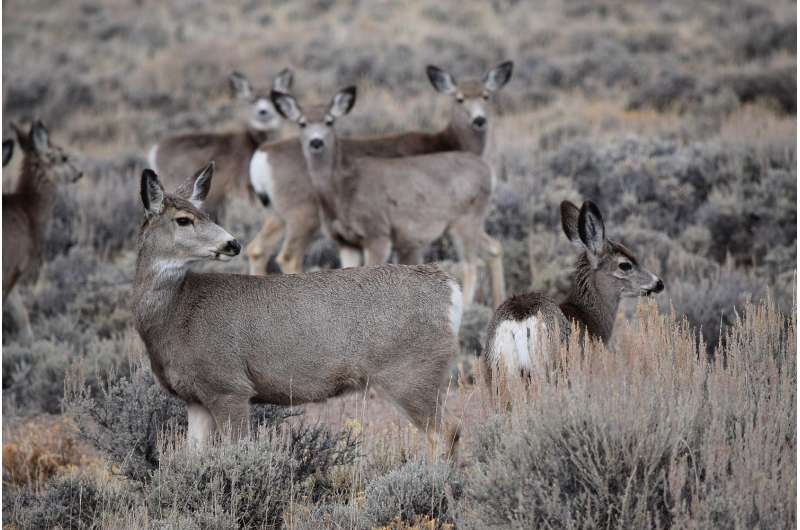Migrating mule deer track 'green waves' of spring forage

Migratory mule deer in Wyoming closely time their movements to track the spring green-up, providing evidence of an underappreciated foraging benefit of migration, according to a new study from a team of researchers led by University of Wyoming and U.S. Geological Survey (USGS) scientists at the Wyoming Cooperative Fish and Wildlife Research Unit.
Biologists have long understood that migration corridors are important for enabling animals to move between winter and summer ranges, but corridors themselves were not actually understood as habitat. However, this new research has documented that these economically and ecologically important game animals are not just moving from low-elevation winter range to high-elevation summer range. Rather, the daily movements of migratory mule deer are closely timed to track spring green-up, known as "surfing the green wave."
The new results indicate deer's surfing includes stopping over at various points along the way, prolonging the animals' exposure to high-quality forage along the entire migration route. The findings are reported in a paper released to the public last week. The paper will be published in the June issue of the scientific journal Ecology Letters.
"When we looked at the deer movement data and aligned it with the timing of spring green-up at each location, we were amazed," says Matt Kauffman, director of the Wyoming Migration Initiative, UW professor and USGS researcher at the Wyoming Cooperative Fish and Wildlife Research Unit. "These deer have an almost uncanny ability to keep pace with the spring timing of the greening. And that allows them to get the highest quality forage, when plants are first greening up. Their movements fit the predictions of the green wave hypothesis almost perfectly."
The researchers gathered movement data from 99 adult female mule deer—ranging from 2-12 years of age—which migrate north in spring along the Wyoming Range, a productive mountain range in western Wyoming that is the southern extent of the greater Yellowstone ecosystem. The deer were fitted with GPS tracking collars that logged their locations every 1-5 hours. For three years, daily movements of deer during the spring migration were matched with dynamic maps (from remote sensing imagery) to determine how closely each deer's movements overlapped with the timing of early spring green-up, when the nutritional value of vegetation peaks. All deer showed evidence of green-wave surfing, and roughly one third of them perfectly matched their movements to the timing of green-up.
Little is known about what makes one deer surf well and another surf poorly. The study found that the degree to which mule deer surfed the green wave along their migratory routes was unrelated to their age or body condition. Instead, how well deer surfed depended on the manner in which the spring green-up spread across the landscape. Mule deer surfed better when their migration routes had a longer green-up period, a more rapid rate of green-up, and when the timing of green-up progressed consecutively from winter to summer range. The researchers have dubbed this characterization of the green-up pattern the "greenscape." A route's greenscape was the primary factor determining how well individual deer surfed the green wave.
"Viewing migration as a movement strategy driven by these resource waves challenges traditional concepts of migration," says Ellen Aikens, lead author and doctoral researcher in the Wyoming Cooperative Fish and Wildlife Research Unit. "This research shows that management and future studies must consider how habitat along the migratory corridor influences movement and foraging as mule deer migrate."
"The sophisticated analysis used here sets a new standard for work on migration of large herbivores. It is a very impressive coupling of extensive movement data with satellite data," says Atle Mysterud, professor at the University of Oslo. "It allows a new level of detail in separating out the behavioral and the landscape part of green-wave surfing."
More information: Ellen O. Aikens et al, The greenscape shapes surfing of resource waves in a large migratory herbivore, Ecology Letters (2017). DOI: 10.1111/ele.12772
Journal information: Ecology Letters
Provided by University of Wyoming

















